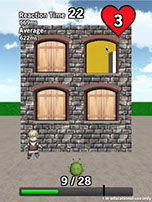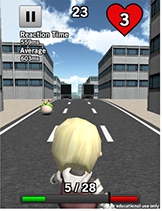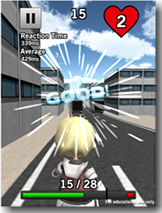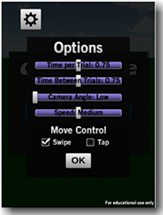OCD - GET OUT OF ME
a therapeutic neurogame to treat obsessive-compulsive-disorder

THE PROBLEM
Obsessive-compulsive-disorder affects around 12% of the population. That is 40 million people people in the US of which three million fall in the clinical spectrum. Even though obsessions and compulsions cause significant distress in daily life, people generally struggle up to 10 years before seeking treatment. As for every illness, early intervention is key. Moreover, normal treatment is often experienced as difficult and aversive, leading to high drop out rates of 25%. Until today there has been no real practical solution for self-help that is enjoyable enough to encourage people to continue with their treatment.
Obsessive-Compulsive Disorder
OCD is an anxiety disorder characterized by obsessive thoughts and compulsive actions, such as cleaning, checking, counting, or hoarding. Individuals who suffer from OCD become trapped in a pattern of repetitive thoughts and behaviors that are senseless and distressing but extremely difficult to overcome.
Maladaptive behavior-chain of OCD - breaking three links of the chain
- Obsessions: learned fear reaction of the brain as response to stimuli associated with contamination
- Impulsivity: deficits in ability to resist impulses (i.e. cleaning)
- Compulsivity: deficits in ability to stop already initiated behavior (i.e. cleaning)

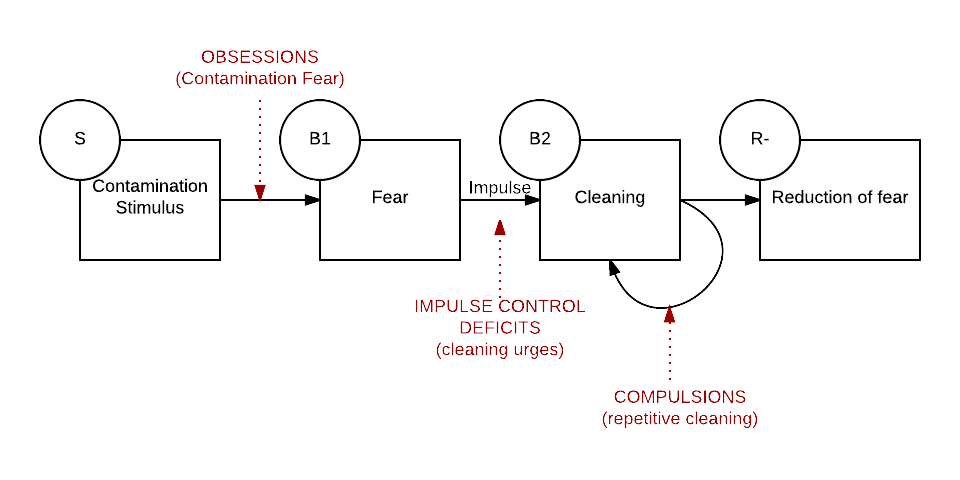
THE SOLUTION: A THERAPEUTIC NEUROGAME
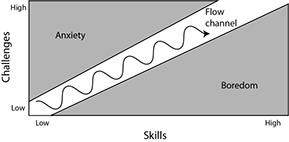
![]()
WHY A GAME? - lower barrier to treatment- mundane tasks become more interesting- anxiety inducing procedures become less difficult
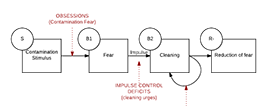
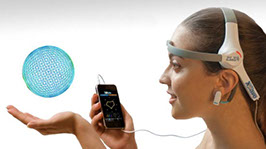

BREAKING THE BEHAVIOR CHAIN The game trains people's brain to- better resist cleaning impulses- better stop compulsive cleaning behavior- overcome contamination fear

BRAIN-COMPUTER INTERFACE We integrated cutting-edge brain-computer-interface technology to get at the core problem of OCD. It measures users' mental emotional state while playing the game.
FINDING THE SOLUTION
Approach: Reading, reading, reading
- Reading about OCD and specific neuronal deficits
- Reading in OCD forums what people say about current self-help opportunities
- Asking people with OCD what kind of app they would like to see
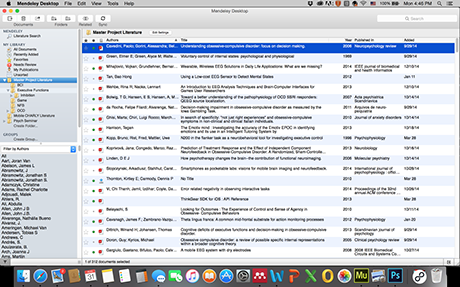

Questions that guided my research:
- How can psychological interventions be mapped onto a mobile app - keeping in mind that no therapist would guide the process?
- Is it possible to re-learn inhibitory control? Is research with alcoholism and ADHD transferable to OCD? How can we stay as close as possible to existing research?
- Personal Insight: Psychological science is really good in identifying and explaining problems, but rarely provides solutions.


3 PSYCHOLOGICAL INTERVENTIONS INCORPORATED INTO 1 GAME
ACTION CANCELLATION TRAINING
OCD patients are given a force-choice reaction task. Whenever a stop signal (i.e. soap bubbles) appears right, patients need to stop the already initiated response.

IMPULSE CONTROL
TRAINING:
OCD patients are given a force choice reaction task, in which players need to tap on pictures of germs, while refraining from tapping on pictures of cleaning utensils.
SYSTEMATIC DESENSITIZATION
OCD patients are confronted to a dirty environments, which will evoke fear. The task is to get into a calm mind state. Mental relaxation is measured with brain-computer-interface (BCI) headset.





Go ahead and click through!
NARRATION
MISSION 1: INSTRUCTIONS
MISSION 1: PLAY!
GAME CHARACTERS
MISSION 2: INSTRUCTIONS
MISSION 2: PLAY!
MISSION 3: INSTRUCTIONS
MISSION 3: PLAY!
Once upon a time, there was a town called Cerebrum. Cerebrum used to be a very happy place, populated by the sprightly and cheery Shmutzie folk. This, however, was about to change as Repeticia and Obsess came to invade the town. Obsess is so afraid of losing his power that he suppresses, frightens and threatens Shmutzies to such an extent that they started hiding in dark places. Whenever Shmutzies do not comply, Repeticia sends out Cleaners of her Army of Hygiene. Only a few Shmutzies were able to stay resistant, but are too disorganized to start a revolution.
Now you have been called
to town and commissioned
to bring back peace!

ShmutzCastle
MISSION 1: COLLECT
Repeticia and Obsess have heard that you are in town and know about your plan to start a revolution.
In order to destroy your plan, they took all rebellious Shmutzies and put them in trucks to throw them in the castle’s oriel.
The trucks are already on their way to the castle, but you are lucky! Shmutzies were able to open the back doors of the trucks in order to escape.
One by one, a Shmutzie will jump out of the trucks. Cleaners will jump too and try to catch them again.
Run behind the trucks and pick the Shmutzies up before the Cleaners do!
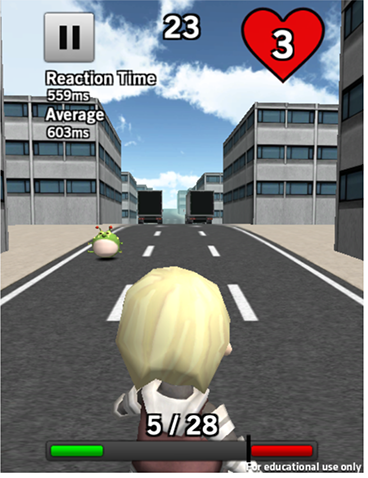



SHMUTZIES: THE GOOD ONES
They will help you win back the town!


CLEANERS: THE BAD ONES
They will try to stop you!
MISSION 2: CONVINCE
In order to fight Obsess and Repeticia you will need more Shmutzies to help you. The rebellious Shmutzies you are trying to rescue from the oriel will not be enough to win this fight.
Find more Shmutzies in the town and convince them that the fear Obsess spreads is not appropriate. Convince them to join your peace corps.
But be careful. Those Shmutzies have built a strong defense mechanism against Cleaners. They have learned to change their appearance and disguise themselves as dirt layer on top of furniture.
Since Shmutzies don’t know about your good intentions yet, they will try to spread fear in you. Keep a calm mind and you are golden!
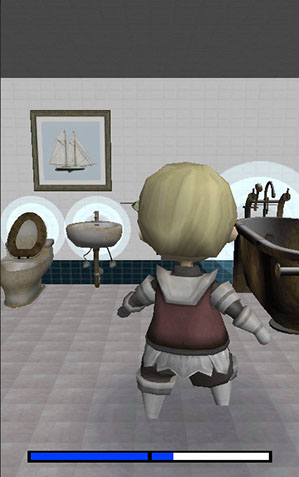
MISSION 3: DEFEAT
Now after you have collected and convinced a number of Shmutzies, it is time for a first attack. Go to the castle and help Shmutzies to storm it. One way of doing so is by catapulting Shmutzies through the windows. Be careful! Cleaners inside the castle will try to defend their territory.
ShmutzCastle is a third-person therapeutic neurogame that plays in a medium sized, modern town called Cerebrum (Latin for brain). The player, represented by an avatar named Evan, will run through different environments, such as streets, shopping malls, train stations, bus stations, houses, restaurants, grocery stores, etc. Within each environment, Evan will have to accomplish three missions. Each of the three missions incorporates one of the three psychological interventions (impulse control training, action cancellation training, and systematic desensitization). A game narrative frames the three missions and its corresponding psychological tasks into a meaningful story line that is metaphorically relevant to the OCD patient and that provides instructions about how to play the game.
See below how the game works!
GAME FLOW - MOCKUP
THE GAME

GAME FLOW - CHART



My role: Everything from invention to final concept (research, ideation, prototype testing, storyboarding & narration).
I worked closely with a developer, who programmed all prototypes in Unity 3D.
2D graphics were drawn by myself, 3D assets were taken from the Unity Asset store.
CURRENT STATUS
The players need to swipe right and left to switch lane sand collect object. The player should collect germs, but refrain from collecting soaps.
The player receives positive and negative feedback in form of sparkling effects or the character turning red.
We build various options for further testing. These include various subjective speeds, different camera angles and three difficulty levels.
Whenever a window opens, the players needs to tap on it in order to catapult the germ into the castle.


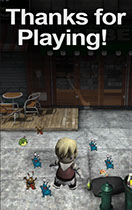
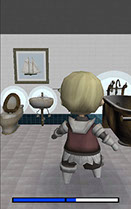
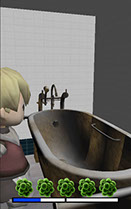
This prototype was build on a two-day Neurogaming Hackathon in San Francisco. Our team made the first place with this prototype.

1st Price

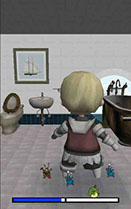
1. You enter the dirty bathroom. The glory effect show you where there are Shmutzies to collect.
2. By increasing your mental relaxation (as measured by the headset you are wearing) you can convince Shmutzies to join your revolution against Repeticia and Obsess.
3. After you have convinced Shmutzies in all available areas (no glory effect left), Shmutzies will follow you to storm the castle in the next mission.
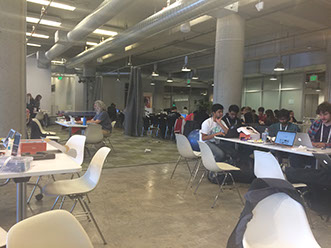
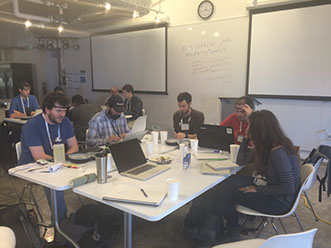
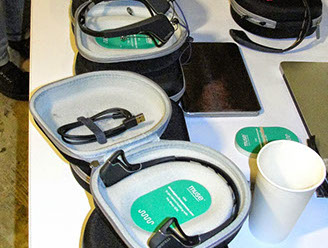
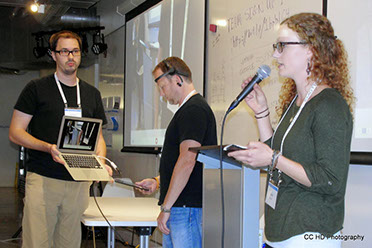
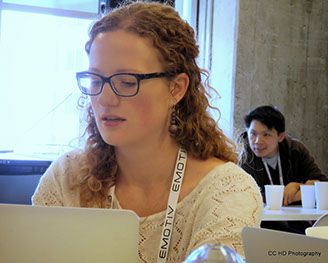
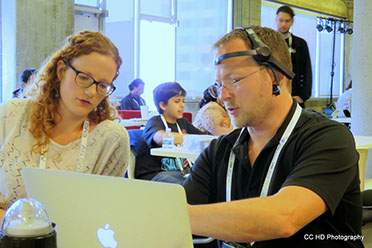
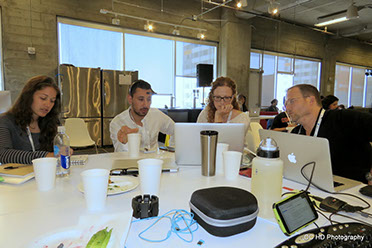
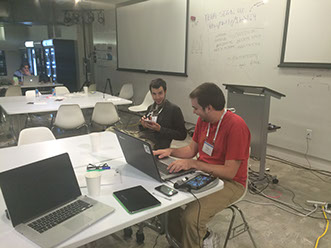



<
>

>> KLICK HERE TO READ ABOUT THE DESIGN PROCESS
RESEARCH
DEFINE



CONCEPT & STRATEGY



IDEATE

TEST
INTERACTION DESIGN



PROTOTYPE
SKETCHES & WIREFRAMES
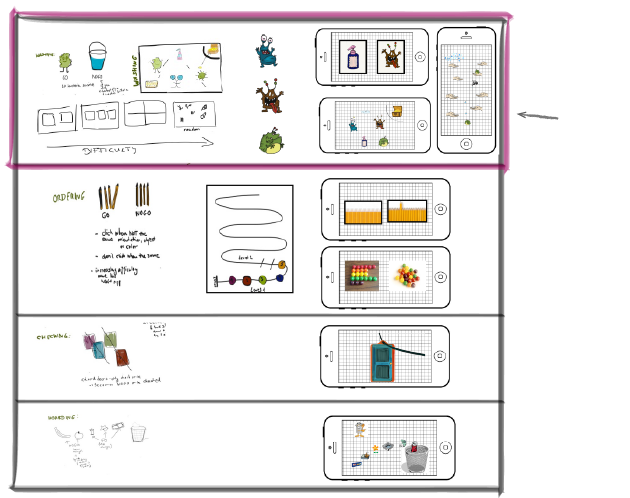
SELECTION
Decision to focus on contamination/cleaning OCD
SUB-GAME I (Impulse Control Training)
INTERACTION DESIGN




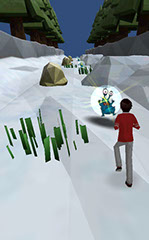


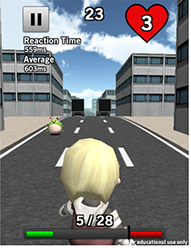
PROTOTYPE I
PROTOTYPE II
PROTOTYPE III
The first prototype was a very direct translation of the original scientific task (Go-Nogo). An object (germ or soap) appears ever second on the screen. Users need to tap as fast as possible on germs, while refraining from tapping on soaps. User tests, however, revealed that this visualization is too mundane to keep users motivated in playing repeatedly. We decided to add motion and 3D to the game. To prevent that the player sees the next object before he/she has reacted to the previous one, we were forced to hide germs and soaps behind objects, such as stones. In prototype three we came up with a more elegant solution by hiding soaps and germs in trucks. In this version we also created 3D germs and soaps and developed diverse viewer perspectives and subjective speeds (how fast the character is running and how fast trucks are moving).
SUB-GAME II (Action Cancellation Training)

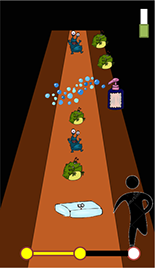


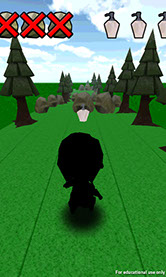


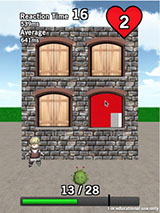
MOCKUP
PROTOTYPE I
PROTOTYPE II
The initial idea was to create a runner game for this sub-game as well. In prototype one players were supposed to change lanes depending on which one is free. However, when a soap appears, players should stay on that lane in order to kick the soap. User testing, however, revealed that the interaction is not intuitive enough. Even after repeated explaining, users did not understand what they were supposed to do. We concluded that the runner style doesn't work with the scientific task that should be gamified here. In prototype two players need to click as fast as possible on the opening window in order to catapult germs into the castle. However, when soap bubble appear, players need to cancel their already initiated action and refrain from tapping on the window.
SUB-GAME III (Systematic Desensitization)
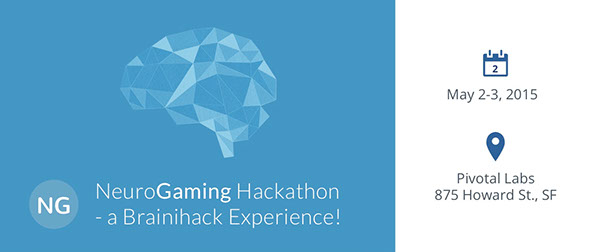

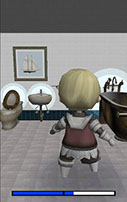
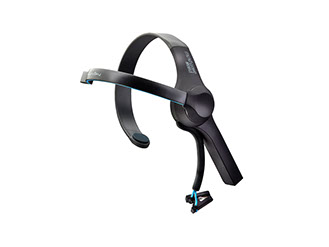
+
This prototype was developed on a weekend during the NeuroGaming Hackathon in San Francisco and won 1st price. Sub-game 3 is the only one that connects to the brain-computer-interface headset. As prize we were allowed to have a booth at the following three-day conference, where we received a lot of positive Feedback. Conference visitors who tested the prototype showed no significant problems with the interface or with the headset. Some criticized that the germs above the blue relaxation bar do not look like icky germs, and the jumping of the germs could be more elegant. This feedback will be included into further designs.
LIKE WHAT YOU SEE? CHECK OUT SOME OF MY OTHER PROJECTS:
USER INTERFACE DESIGN
BIOFEEDBACK VISUALIZATIONS
INSTRUCTIONAL DESIGN
PHOTOGRAPHY WEBSITE
2015 Linda Weber


